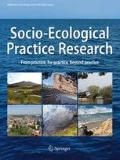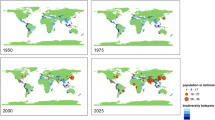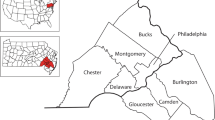Abstract
Ian McHarg provided critical direction toward Texas’s urban settlement planning during the 1970s, an era of transformation and vision, in which he developed the Lake Austin Growth Management Plan and a plan for The Woodlands. Texas continues to undergo dramatic changes, with a projected doubling of population by 2050 and escalation of extreme weather events. In response, the University of Texas at Austin recently launched Planet Texas 2050 (PT2050), a decade-long grand challenge research program focused on developing knowledge and strategies needed to plan for resilience in the face of climate and population change. This article investigates the following research question: How does Planet Texas 2050 build and innovate upon McHarg’s ecological survey method for the purpose of planning a resilient Texas? I analyze McHarg’s ecological survey method and use the examples from The Woodlands and Planet Texas 2050 to explore the development of a socio-ecological survey. This investigation identifies several findings relevant for research and practice. It is possible that earlier and better integration of social data into The Woodlands’ ecological survey may have helped the planning team anticipate objections which influenced the abandonment of ecological planning for the second phase of The Woodlands’ development, resulting in a loss of ecosystem services. Almost 50 years later, Planet Texas 2050 has attempted to build a dynamic socio-ecological survey that integrates diverse socio-ecological data, co-produces socio-ecological knowledge with the public, and incorporates socio-ecological data from the past. Although PT2050 may fall short of its ambitious goal to ensure a resilient Texas by mid-century, growing system complexity and socio-ecological change ensure that surveys, such as McHarg’s ecological survey and Planet Texas 2050s socio-ecological survey, will remain a key component of future resilience planning.


Similar content being viewed by others
References
Berkes F, Folke C, Colding J (eds) (1998) Linking social and ecological systems. Management practices and social mechanisms for building resilience. Cambridge University Press, Cambridge
Bixler RP, Lieberknecht K, Leite F, Felkner J, Oden M, Richter SM, Thomas R (2019) An observatory framework for metropolitan change: understanding urban social–ecological–technical systems in texas and beyond. Sustainability 11(13):3611
Brown K (2013) Global environmental change I. Prog Hum Geogr 38(1):107–117
Choudary W, Wu J, Zhang M (2018) Neighborhood Gentrification across Harris County: 1990 to 2016
Coffman L (2000) Low-impact development design strategies: an integrated design approach. EPA 841-B-00-003. Department of Environmental Resources, Programs and Planning Division, Prince George’s County, Maryland
Forsyth A (2002) Planning lessons from three US new towns of the 1960s and 1970s: Irvine, Columbia, and The Woodlands. J Am Plan Assoc 68(4):387–415. https://doi.org/10.1080/01944360208976282
Forsyth A (2005) Reforming suburbia: the planned communities of Irvine, Columbia, and the Woodlands. University of California Press
Galatas R, Barlow J (2004) The Woodlands: the inside story of creating a better hometown. ULI-the Urban Land Institute
Girling C, Kellett R (2005) Skinny streets and green neighborhoods: design for environment and community. Island Press
Karvonen A (2011) Politics of urban runoff: nature, technology, and the sustainable city. MIT Press, Boston
Klineberg SL, Wu J, Barrera C (2014) What accounts for health disparities? Findings from the Houston Surveys (2001–2013). https://kinder.rice.edu/research/what-accounts-health-disparities-findings-houston-surveys-2001-2013. Accessed 15 Aug 2019
Kutchin J (1998) When you’re convinced you’re right, go for it. How Mitchell Energy and Development Corp. got its start and how it grew: An oral history and narrative overview, pp 1–40
Lieberknecht K (2018a) “Making texas resilient is a moonshot goal.” Texas Tribune. September 20, 2018. https://www.tribtalk.org/2018/09/20/making-texas-resilient-is-a-moonshot-goal/. Accessed 15 Aug 2019
Lieberknecht K (2018b) Fencelines and observatories: two texas communities navigating change. Platform, 2018-2019:12. https://soa.utexas.edu/publications/platform-complexity-scale-power. Accessed 15 Aug 2019
Madere M (2008) Tropical weather: the woodlands archives (Houston Chronicle). Retrieved from http://blogs.chron.com/hurricanes/the_woodlands/. Accessed 15 Aug 2019
Martin Prosperity Institute (2016) Segregated city: the geography of economic segregation in America’s Metros. http://martinprosperity.org/media/Segregated%20City.pdf. Accessed 15 Aug 2019
McHarg IL (1969) Design with nature. American Museum of Natural History, New York
McHarg IL (1976) Regional Goals for Planned Growth. Prepared for the Toledo Metropolitan Area Council for Governments. Wallace, McHarg, Roberts and Todd, Philadelphia
McHarg IL (1996) A quest for life: an autobiography. Wiley
McHarg IL (2007) The theory of creative fitting. In: Margulis L, Corner J, Hawthorne B (eds) Ian McHarg: conversations with students: dwelling in nature. Princeton Architectural Press, New York, pp 19–61
McHarg IL, Steiner FL (eds) (1998) To heal the earth: selected writings of Ian L. Island Press, Washington, DC, McHarg
Moore SA, Torrado M, Joslin N (2019) Knowledge production for interdependent critical infrastructures: constructing context-rich relationships across ecosociotechnical boundaries. Environ Sci Policy 99:97–104
National Oceanic and Atmospheric Administration (NOAA) (2000) National weather service storm data and unusual weather phenomena. Retrieved from https://www.srh.noaa.gov/hgx/severe/2000/apr00hgx.pdf. Accessed 15 Aug 2019
Pachauri RK, Allen MR, Barros VR, Broome J, Cramer W, Christ R, Dubash NK (2014) Climate change 2014: synthesis report. Contribution of Working Groups I, II and III to the fifth assessment report of the Intergovernmental Panel on Climate Change (p 151). Ipcc
Pahl-Wostl C, Bhaduri A, Gupta J (eds) (2016) Handbook on water security. Edward Elgar Publishing, Cheltenham
Partelow S, Winkler K (2016) Interlinking ecosystem services and Ostrom’s framework through orientation in sustainability research. Ecol Soc 21(3):27
Pew Research Center (2012) The rise of residential segregation by income. http://www.pewsocialtrends.org/files/2012/08/Rise-of-Residential-Income-Segregation-2012.2.pdf. Accessed 15 Aug 2019
Potter LB, Hoque N (2014) Texas population projections, 2010 to 2050. Office of The State Demographer, Austin
Preiser R, Biggs R, De Vos A, Folke C (2018) Social-ecological systems as complex adaptive systems: organizing principles for advancing research methods and approaches. Ecol Soc 23(4):45
PT2050 Theme Organizing Committee (2017) PT2050: Planning for a resilient Texas. The University of Texas at Austin Office of the Vice President of Research, Austin
Redman CL, Grove JM, Kuby LH (2004) Integrating social science into the long-term ecological research (LTER) network: social dimensions of ecological change and ecological dimensions of social change. Ecosystems 7(2):161–171
Schoon M, van der Leeuw S (2015) Dossier: «À propos des relations natures/sociétés»—The shift toward social-ecological systems perspectives: insights into the human–nature relationship. Nat Sci Soc 23(2):166–174. https://doi.org/10.1051/nss/2015034
Shi L, Chu E, Anguelovski I, Aylett A, Debats J, Goh K, Roberts JT (2016) Roadmap towards justice in urban climate adaptation research. Nat Clim Change 6(2):131
Smith AB, Matthews JL (2015) Quantifying uncertainty and variable sensitivity within the US billion-dollar weather and climate disaster cost estimates. Nat Hazards 77(3):1829–1851
Steiner F (2018) Making plans: how to engage with landscape, design, and the urban environment. The University of Texas Press, Austin
Sung CY (2013) Mitigating surface urban heat island by a tree protection policy: A case study of The Woodland, Texas, USA. Urban Forest Urban Greening 12(4):474–480
Taylor P, Fry RA (2012) The rise of residential segregation by income. Pew Research Center, Washington, DC
Texas Health Data Center for Health Statistics (2013) Health Facts Profiles. Texas Department of Health Services. http://healthdata.dshs.texas.gov/HealthFactsProfiles. Accessed 15 Aug 2019
Texas Metro Observatory (2019) Summer 2018 research report. The University of Texas School of Architecture, Austin
US Census Bureau (2016) Five of the Nation’s Eleven Fastest-Growing Cities are in Texas, Census Bureau Reports. May 19, 2016. http://www.census.gov/newsroom/press-releases/2016/cb16-81.html
Wallace, McHarg, Roberts & Todd (WMRT) (1973a) Woodlands new community: guidelines for site planning. WMRT, Philadelphia
Wallace, McHarg, Roberts & Todd (WMRT) (1973b) Woodlands new community: phase I: land planning and design principles. WMRT, Philadelphia
Wallace, McHarg, Roberts & Todd (WMRT) (1973c) Woodlands new community: an ecological inventory. WMRT, Philadelphia
Wallace, McHarg, Roberts & Todd (WMRT) (1974) Woodlands new community: an ecological plan. WMRT, Philadelphia
Yang B, Li M-H (2010) Ecological engineering in a new town development: drainage design in The Woodlands, Texas. Ecol Eng 36(12):1639–1650
Yang B, Li M-H (2011) Assessing planning approaches by watershed streamflow modeling: case study of The Woodlands; Texas. Landscape Urban Plann 99(1):9–22
Yang B, Li S (2013) Green infrastructure design for stormwater runoff and water quality: empirical evidence from large watershed-scale community developments. Water 5(4):2038–2057
Yang B, Li M, Huang C (2015) Ian McHarg’s ecological planning in The Woodlands, Texas: lessons learned after four decades. Landsc Res 40(7):773–794
Acknowledgements
This work was supported by Planet Texas 2050, a research grand challenge at the University of Texas at Austin.
Author information
Authors and Affiliations
Corresponding author
Rights and permissions
About this article
Cite this article
Lieberknecht, K. Building and innovating upon McHarg’s ecological survey: the Texas case. Socio Ecol Pract Res 1, 283–296 (2019). https://doi.org/10.1007/s42532-019-00025-3
Received:
Accepted:
Published:
Issue Date:
DOI: https://doi.org/10.1007/s42532-019-00025-3




